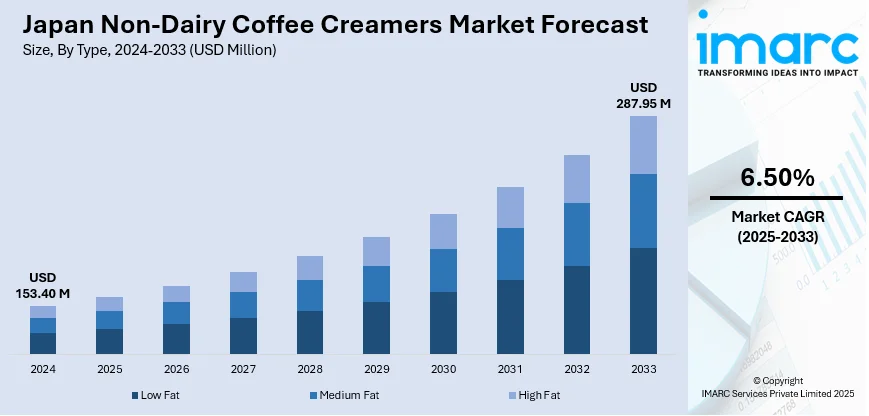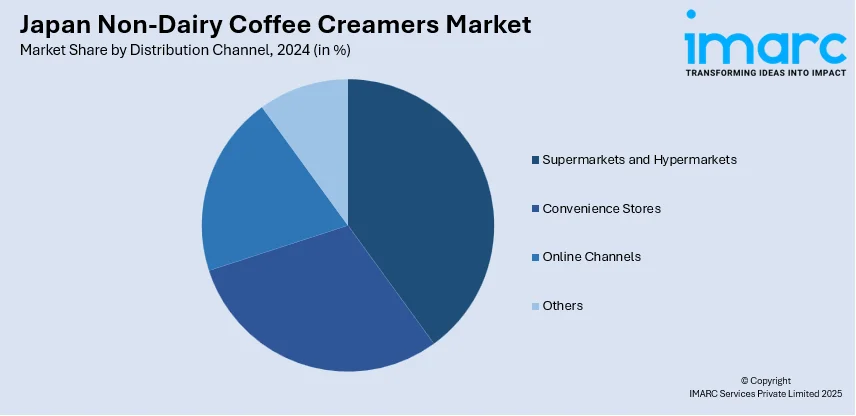
Japan Non-Dairy Coffee Creamers Market Size, Share, Trends and Forecast by Type, Form, Source, Flavor, Distribution Channel, and Region, 2025-2033
Japan Non-Dairy Coffee Creamers Market Overview:
The Japan non-dairy coffee creamers market size reached USD 153.40 Million in 2024. Looking forward, IMARC Group expects the market to reach USD 287.95 Million by 2033, exhibiting a growth rate (CAGR) of 6.50% during 2025-2033. The growth of non-dairy coffee creamers market in Japan is driven by increased product availability, escalating demand for clean-label options, and a growing health-conscious consumer base. Retail expansion, e-commerce, transparency in labeling, and healthier dietary trends are also contributing to the expansion of the Japan non-dairy coffee creamers market share.
|
Report Attribute
|
Key Statistics
|
|---|---|
|
Base Year
|
2024
|
|
Forecast Years
|
2025-2033
|
|
Historical Years
|
2019-2024
|
| Market Size in 2024 | USD 153.40 Million |
| Market Forecast in 2033 | USD 287.95 Million |
| Market Growth Rate 2025-2033 | 6.50% |
Japan Non-Dairy Coffee Creamers Market Trends:
Product Availability and Retail Expansion
The growing presence of non-dairy coffee creamers in different retail outlets is impelling the market expansion in Japan. With the increasing demand for these products, retailers are broadening their offerings to align with consumer preferences. Non-dairy creamers are gaining popularity in supermarkets, convenience stores, and online marketplaces, offering consumers a wider range of choices. The growth of e-commerce is notably significant, allowing buyers to explore and purchase non-dairy creamers from the ease of their homes, with the benefit of home delivery. This increasing availability is expanding the accessibility of non-dairy creamers, allowing more individuals to incorporate them into their everyday coffee routines. Moreover, Japan's retail sector, valued at USD 1,779.7 billion in 2024, is expected to rise to USD 2,006.9 billion by 2033, suggesting that the enhanced accessibility of these products aligns with a larger trend in retail growth, thereby encouraging non-dairy alternatives.

To get more information on this market, Request Sample
Increased Focus on Clean-Label Products
Consumers in Japan are increasingly selective regarding the ingredients in their food and drinks, favoring options that contain simple, natural, and familiar components. Clean-label products are considered healthier as they lack artificial additives, preservatives, and excess sugars. This trend indicates a larger shift towards openness in food manufacturing, where buyers appreciate items that explicitly detail their components. Non-dairy creamers that emphasize being 100% natural or without artificial ingredients are especially favored, as they align with a preference for healthy, unprocessed foods. Furthermore, the growing efforts of the governing body to ensure stringent labeling of products is positively influencing the market. For instance, as of January 2, 2024, Japan implemented more stringent product labeling at the point of sale, mandating country of origin details on items. Such actions are encouraging producers to adhere to regulations, guaranteeing commitment to updated standards and fulfilling the need for cleaner, more transparent goods.
Health Consciousness and Dietary Trends
The rising emphasis on health and wellness is influencing the Japan non-dairy coffee creamers market growth. With the increasing health awareness, many consumers are shifting from dairy products because of lactose intolerance, vegan choices, and a desire to lower saturated fat intake. Non-dairy creamers, typically derived from plant sources, such as soy, almond or oat are viewed as healthier options that correspond with these lifestyle adjustments. This change is particularly evident among younger, health-aware people and older adults dealing with health issues like high cholesterol. In response, producers are expanding their selections by adding plant-based, low-sugar, and nutrient-dense options to satisfy these needs. This trend is additionally supported by the overall expansion of Japan's health and wellness market, which hit USD 207.28 billion in 2024 and is estimated to increase to USD 287.50 billion by 2033, indicating a 3.51% CAGR from 2025 to 2033. Non-dairy creamers are emerging as an essential part of Japan’s health-focused food culture.
Japan Non-Dairy Coffee Creamers Market Segmentation:
IMARC Group provides an analysis of the key trends in each segment of the market, along with forecasts at the country and regional levels for 2025-2033. Our report has categorized the market based on type, form, source, flavor, and distribution channel.
Type Insights:
- Low Fat
- Medium Fat
- High Fat
The report has provided a detailed breakup and analysis of the market based on the type. This includes low fat, medium fat, and high fat.
Form Insights:
- Powder
- Liquid
A detailed breakup and analysis of the market based on the form have also been provided in the report. This includes powder and liquid.
Source Insights:
- Almond
- Coconut
- Soy
- Others
The report has provided a detailed breakup and analysis of the market based on the source. This includes almond, coconut, soy, and others.
Flavor Insights:
- French Vanilla
- Caramel
- Hazelnut
- Irish Crème
- Others
A detailed breakup and analysis of the market based on the flavor have also been provided in the report. This includes French vanilla, caramel, hazelnut, Irish crème, and others.
Distribution Channel Insights:

- Supermarkets and Hypermarkets
- Convenience Stores
- Online Channels
- Others
A detailed breakup and analysis of the market based on the distribution channel have also been provided in the report. This includes supermarkets and hypermarkets, convenience stores, online channels, and others.
Regional Insights:
- Kanto Region
- Kansai/Kinki Region
- Central/ Chubu Region
- Kyushu-Okinawa Region
- Tohoku Region
- Chugoku Region
- Hokkaido Region
- Shikoku Region
The report has also provided a comprehensive analysis of all the major regional markets, which include Kanto Region, Kansai/Kinki Region, Central/ Chubu Region, Kyushu-Okinawa Region, Tohoku Region, Chugoku Region, Hokkaido Region, and Shikoku Region.
Competitive Landscape:
The market research report has also provided a comprehensive analysis of the competitive landscape. Competitive analysis such as market structure, key player positioning, top winning strategies, competitive dashboard, and company evaluation quadrant has been covered in the report. Also detailed profiles of all major companies have been provided.
Japan Non-Dairy Coffee Creamers Market Report Coverage:
| Report Features | Details |
|---|---|
| Base Year of the Analysis | 2024 |
| Historical Period | 2019-2024 |
| Forecast Period | 2025-2033 |
| Units | Million USD |
| Scope of the Report |
Exploration of Historical Trends and Market Outlook, Industry Catalysts and Challenges, Segment-Wise Historical and Future Market Assessment:
|
| Types Covered | Low Fat, Medium Fat, High Fat |
| Forms Covered | Powder, Liquid |
| Sources Covered | Almond, Coconut, Soy, Others |
| Flavours Covered | French Vanilla, Caramel, Hazelnut, Irish Crème, Others |
| Distribution Channels Covered | Supermarkets and Hypermarkets, Convenience Stores, Online Channels, Others |
| Regions Covered | Kanto Region, Kansai/Kinki Region, Central/ Chubu Region, Kyushu-Okinawa Region, Tohoku Region, Chugoku Region, Hokkaido Region, Shikoku Region |
| Customization Scope | 10% Free Customization |
| Post-Sale Analyst Support | 10-12 Weeks |
| Delivery Format | PDF and Excel through Email (We can also provide the editable version of the report in PPT/Word format on special request) |
Key Questions Answered in This Report:
- How has the Japan non-dairy coffee creamers market performed so far and how will it perform in the coming years?
- What is the breakup of the Japan non-dairy coffee creamers market on the basis of type?
- What is the breakup of the Japan non-dairy coffee creamers market on the basis of form?
- What is the breakup of the Japan non-dairy coffee creamers market on the basis of source?
- What is the breakup of the Japan non-dairy coffee creamers market on the basis of flavor?
- What is the breakup of the Japan non-dairy coffee creamers market on the basis of distribution channel?
- What is the breakup of the Japan non-dairy coffee creamers market on the basis of region?
- What are the various stages in the value chain of the Japan non-dairy coffee creamers market?
- What are the key driving factors and challenges in the Japan non-dairy coffee creamers market?
- What is the structure of the Japan non-dairy coffee creamers market and who are the key players?
- What is the degree of competition in the Japan non-dairy coffee creamers market?
Key Benefits for Stakeholders:
- IMARC’s industry report offers a comprehensive quantitative analysis of various market segments, historical and current market trends, market forecasts, and dynamics of the Japan non-dairy coffee creamers market from 2019-2033.
- The research report provides the latest information on the market drivers, challenges, and opportunities in the Japan non-dairy coffee creamers market.
- Porter's five forces analysis assist stakeholders in assessing the impact of new entrants, competitive rivalry, supplier power, buyer power, and the threat of substitution. It helps stakeholders to analyze the level of competition within the Japan non-dairy coffee creamers industry and its attractiveness.
- Competitive landscape allows stakeholders to understand their competitive environment and provides an insight into the current positions of key players in the market.
Need more help?
- Speak to our experienced analysts for insights on the current market scenarios.
- Include additional segments and countries to customize the report as per your requirement.
- Gain an unparalleled competitive advantage in your domain by understanding how to utilize the report and positively impacting your operations and revenue.
- For further assistance, please connect with our analysts.
 Request Customization
Request Customization
 Speak to an Analyst
Speak to an Analyst
 Request Brochure
Request Brochure
 Inquire Before Buying
Inquire Before Buying




.webp)




.webp)












